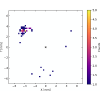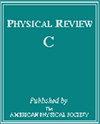Investigating the effects of precise mass measurements of Ru and Pd isotopes on machine learning mass modeling
IF 3.4
2区 物理与天体物理
Q1 Physics and Astronomy
引用次数: 0
Abstract
Atomic masses are a foundational quantity in our understanding of nuclear structure, astrophysics, and fundamental symmetries. The longstanding goal of creating a predictive global model for the binding energy of a nucleus remains a significant challenge, however, and prompts the need for precise measurements of atomic masses to serve as anchor points for model developments. We present precise mass measurements of neutron-rich Ru and Pd isotopes performed at the Californium Rare Isotope Breeder Upgrade facility at Argonne National Laboratory using the Canadian Penning Trap mass spectrometer. The masses of , and were measured to a relative mass precision via the phase-imaging ion-cyclotron-resonance technique, and represent an improvement of approximately an order of magnitude over previous measurements. These mass data were used in conjunction with the physically interpretable machine learning (PIML) model, which uses a mixture density neural network to model mass excesses via a mixture of Gaussian distributions. The effects of our new mass data on a Bayesian-updating of a PIML model are presented.

研究 Ru 和 Pd 同位素的精确质量测量对机器学习质量建模的影响
原子质量是我们理解核结构、天体物理学和基本对称性的基础量。然而,为原子核结合能创建一个预测性全局模型的长期目标仍然是一个重大挑战,这也促使我们需要对原子质量进行精确测量,以作为模型开发的锚点。我们介绍了在阿贡国家实验室的加州稀有同位素育种升级设施中使用加拿大潘宁阱质谱仪对富含中子的 Ru 和 Pd 同位素进行的精确质量测量。通过相位成像离子-回旋共振技术测量了 Ru108、Ru110 和 Pd116 的质量,相对质量精度为 δm/m≈10-8,比以前的测量结果提高了大约一个数量级。这些质量数据与物理可解释机器学习(PIML)模型结合使用,该模型使用混合密度神经网络,通过高斯分布的混合来模拟质量过剩。本文介绍了新质量数据对贝叶斯更新 PIML 模型的影响。
本文章由计算机程序翻译,如有差异,请以英文原文为准。
求助全文
约1分钟内获得全文
求助全文
来源期刊

Physical Review C
物理-物理:核物理
CiteScore
5.70
自引率
35.50%
发文量
0
审稿时长
1-2 weeks
期刊介绍:
Physical Review C (PRC) is a leading journal in theoretical and experimental nuclear physics, publishing more than two-thirds of the research literature in the field.
PRC covers experimental and theoretical results in all aspects of nuclear physics, including:
Nucleon-nucleon interaction, few-body systems
Nuclear structure
Nuclear reactions
Relativistic nuclear collisions
Hadronic physics and QCD
Electroweak interaction, symmetries
Nuclear astrophysics
 求助内容:
求助内容: 应助结果提醒方式:
应助结果提醒方式:


